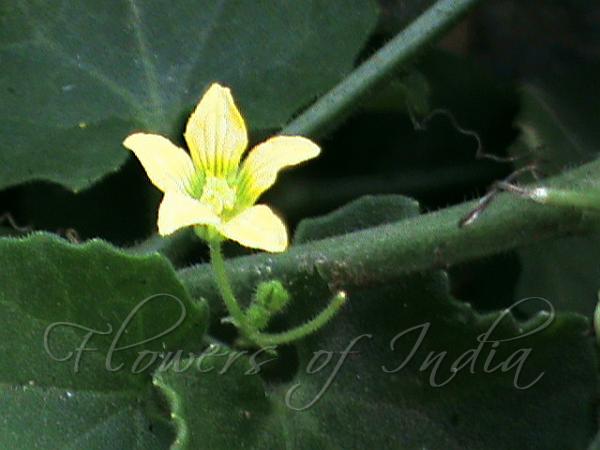|
| Stinking Kedrostis |
|

|

| File size | 77435 |
| Original date | 12/30/14 4:08 PM |
| Resolution | 640 x 480 |
| Flash | Flash did not fire, auto |
| Focal length | 8.2mm |
| Exposure time | 1/50s |
| Aperture | 2.0 |
| Focus Distance | |
| Metering Mode | Multi-segment |
| Camera make | SONY |
| Camera model | DCR-SR47E |
| Sensor type |
|
|
|
|
Photo: |
Botanical name: Kedrostis foetidissima Family: Cucurbitaceae (Pumpkin family)
Synonyms: Melothria foetidissima, Trichosanthes foetidissima
Synonyms: Melothria foetidissima, Trichosanthes foetidissima
Stinking Kedrostis is a perennial plant, producing
annual stems which are climbing, not spreading. Leaves are stalked,
shortly velvety or rough, ovate, 2-4 cm long and as broad. Base is
deeply notched, tip pointed, margin entire, wavy or toothed, tendril
threadlike. Male flowers are usually borne in pairs, 0.5-1.5 cm long.
Calyx tube is hemispherical, shortly and sparsely hairly, about 2 mm
long, teeth narrowly triangular. Petals are yellow, oblong lanceshaped,
pointed, about 4 mm long. Female inflorescence is 1-7 mm long. Fruit is
deep red, ovoid, stalkless or nearly so, 1.0-2.5 x 0.8-1.2 cm, 1-5
seeded. The edible portions of the plant such as tubers, rhizome, and
stem, are consumed by tribal people. Stinking Kedrostis is found in
India, Bangladesh, Burma, Pakistan and Tropical E. Africa.
Medicinal uses: As an ethnomedical plant, it
can be used for treating aliments, common cold, diarrhea, and measles.
The phytochemical analysis of petroleum ether extract of leaf and
chloroform extract of stem revealed the presence of flavonoids,
triterpenoids, phenols, steroids, and glycosides as reported in the
literature.
As an ethnomedical plant, it
can be used for treating aliments, common cold, diarrhea, and measles.
The phytochemical analysis of petroleum ether extract of leaf and
chloroform extract of stem revealed the presence of flavonoids,
triterpenoids, phenols, steroids, and glycosides as reported in the
literature.
Medicinal uses:
 As an ethnomedical plant, it
can be used for treating aliments, common cold, diarrhea, and measles.
The phytochemical analysis of petroleum ether extract of leaf and
chloroform extract of stem revealed the presence of flavonoids,
triterpenoids, phenols, steroids, and glycosides as reported in the
literature.
As an ethnomedical plant, it
can be used for treating aliments, common cold, diarrhea, and measles.
The phytochemical analysis of petroleum ether extract of leaf and
chloroform extract of stem revealed the presence of flavonoids,
triterpenoids, phenols, steroids, and glycosides as reported in the
literature. | Identification credit: S. Kasim | Photographed in Ranipet, Tamil Nadu. |
• Is this flower misidentified? If yes,